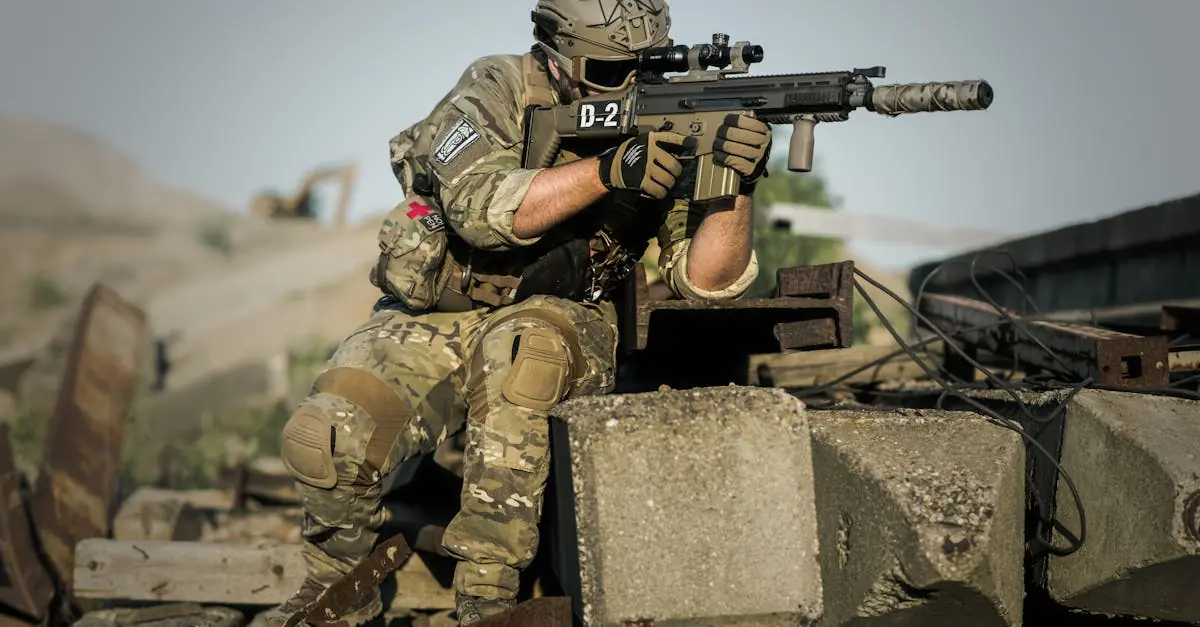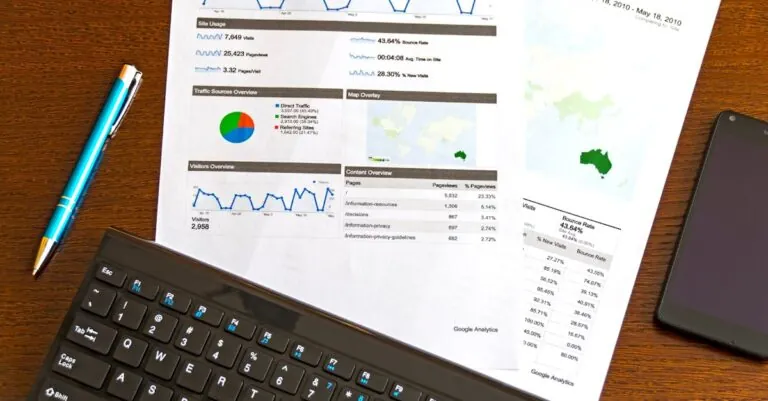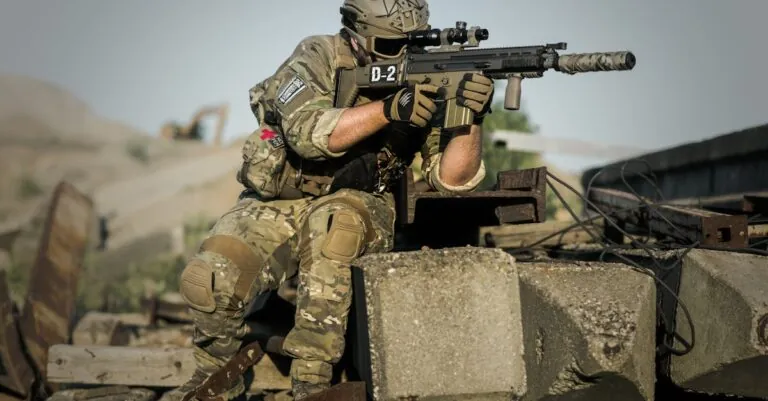Table of Contents
ToggleIn a world where peace is often just a coffee break away from chaos, military readiness evaluation stands as the unsung hero of national security. Picture this: troops ready to spring into action faster than a cat on a hot tin roof. It’s not just about having the latest gadgets or the sharpest uniforms; it’s about ensuring every soldier is battle-ready, mentally and physically.
Understanding Military Readiness Evaluation
Military readiness evaluation assesses the capabilities and preparedness of military forces. This process encompasses various dimensions, including personnel readiness, equipment reliability, and operational capacity.
Definition of Military Readiness
Military readiness refers to the state of armed forces to perform their assigned missions effectively. It includes factors such as training, equipment availability, and personnel fitness. An optimal readiness level ensures troops can respond quickly and efficiently to threats. Measurement tools often evaluate both individual and unit performance. This comprehensive concept also encompasses mental preparedness and adaptability during various scenarios.
Importance of Readiness Evaluation
Readiness evaluation plays a crucial role in national security. Accurate assessments enable military leaders to identify strengths and weaknesses within their forces. Such evaluations inform strategic decisions and resource allocation. Regular readiness checks foster accountability among military personnel, enhancing overall effectiveness. Timely evaluations ensure forces maintain high operational standards, thereby increasing deterrence capabilities. In today’s dynamic environment, staying prepared for unforeseen challenges becomes vital for maintaining peace and stability.
Key Components of Military Readiness Evaluation
Military readiness evaluation encompasses several key components that ensure armed forces can effectively carry out their missions. Each component plays a vital role in assessing overall readiness.
Personnel Readiness
Personnel readiness involves the physical and mental state of military members. Evaluations assess fitness levels, health records, and psychological readiness. Metrics such as deployment history and training completion rates provide insight into individual capabilities. Regular health screenings and well-being programs promote optimal performance and resilience. A strong focus on personnel ensures that soldiers are prepared for the challenges they may face in various environments.
Equipment and Resource Readiness
Equipment and resource readiness focuses on the operational status of military assets. Assessments include checks on machinery, vehicles, and weapons systems to confirm functionality. Metrics like maintenance schedules and failure rates offer clarity on equipment reliability. Preparedness relies on the availability of necessary supplies and provisions. Strategies for logistics and replenishment contribute to sustained operational efficiency, ensuring units can execute their missions without delay.
Training and Tactical Readiness
Training and tactical readiness evaluates the effectiveness of military exercises and simulations. Regular drills and scenario-based training sessions enhance soldiers’ tactical skills and teamwork abilities. Assessment metrics include performance in joint exercises and feedback from commanding officers. Emphasis on real-world scenarios sharpens decision-making skills under pressure. Continuous training updates ensure that forces adapt to evolving threats and operational demands, maintaining a competitive edge in readiness.
Evaluation Methods and Tools
Military readiness evaluation relies on diverse assessment methods and tools. These techniques inform leaders about the overall effectiveness and preparedness of military forces.
Quantitative Assessment Techniques
Quantitative assessment techniques utilize measurable data to evaluate military readiness. Metrics such as personnel fitness scores, equipment failure rates, and training completion percentages provide concrete data points. Analysis often includes calculating the operational availability of equipment, reflecting how often assets are mission capable. Furthermore, surveys assessing troop morale and readiness offer insights into personnel capabilities. These numerical values assist in identifying trends over time, enabling military strategists to make informed decisions about resource allocation and training programs.
Qualitative Assessment Approaches
Qualitative assessment approaches focus on subjective evaluations of military readiness. Observational evaluations of training exercises unveil the effectiveness of tactics and command structures. Interviews with personnel yield insights into psychological readiness and overall morale, which are critical components of operational success. Feedback from field training exercises highlights areas for improvement in strategy and teamwork. Both qualitative and quantitative data work synergistically, guiding leaders toward comprehensive understanding of military preparedness.
Challenges in Military Readiness Evaluation
Various challenges affect military readiness evaluation. Addressing these obstacles is essential for maintaining effective forces.
External Factors Impacting Readiness
Weather events significantly disrupt training schedules and operations. Natural disasters, like hurricanes or floods, can halt movement and testing of military assets. Global political instability influences readiness by shifting priorities or stretching resources thin. Changes in foreign alliances may create unexpected pressure on military commitments. Budget constraints often restrict investment in necessary training and equipment. Fluctuations in funding can limit access to critical resources. Each compounding issue undermines overall preparedness, making it harder for military forces to remain fully operational.
Internal Organizational Challenges
Internal challenges frequently complicate readiness assessments. Inefficient communication within branches can delay decision-making processes. Misalignment between leadership and frontline personnel often results in conflicting priorities. Personnel turnover disrupts consistency in training and reduces unit cohesion. Lack of standardized evaluation protocols wreaks havoc on assessment accuracy. Varying interpretations of readiness criteria lead to discrepancies in reporting. Persistent resistance to change within the military culture stifles innovation. Addressing these challenges directly influences the overall effectiveness of military operations.
Future Trends in Military Readiness Evaluation
Future trends in military readiness evaluation are shaped by technological advancements and evolving military strategies. These shifts aim to enhance overall preparedness and operational effectiveness.
Technological Advancements
Technology continually revolutionizes military readiness evaluation. Innovations such as artificial intelligence streamline data analysis, providing real-time insights into personnel and equipment status. Moreover, large-scale simulations enable comprehensive training environments that reflect various scenarios. Drones and automated systems assess readiness levels more efficiently, reducing the burden on service members. Cybersecurity tools also protect sensitive data, ensuring accurate evaluations free from vulnerabilities. As these technologies integrate into evaluation processes, they enhance decision-making and resource allocation.
Evolving Military Strategies
Evolving military strategies influence how readiness is evaluated. Adaptive approaches focus on hybrid warfare, requiring forces to respond to both conventional and unconventional threats. This adaptability necessitates continuous assessment of training programs to prepare personnel for diverse operational contexts. Emphasis on joint operations demands collaboration among different branches of the military, highlighting the need for standardized evaluation methods across services. Integration of lessons learned from recent conflicts provides insights that refine strategic planning. Prioritizing flexibility in military readiness ensures forces remain effective against emerging threats.
Military readiness evaluation is essential for ensuring that armed forces can effectively respond to a range of challenges. By focusing on personnel, equipment, and training readiness, military leaders can make informed decisions that enhance operational capabilities. Regular assessments not only identify strengths and weaknesses but also foster accountability within military ranks.
As technology continues to evolve, integrating advanced tools and methodologies will further refine readiness evaluations. Addressing both internal and external challenges will be crucial for maintaining a robust military posture. Ultimately, prioritizing military readiness ensures that forces remain prepared to protect national interests and adapt to an ever-changing global landscape.







